
LONDON/NEW YORK, March 3 (Reuters) – The U.S. dollar fell from a 2-1/2-month high against the yen on Friday and was on track for its largest weekly loss versus major peers since mid-January, as traders tried to gauge the path for Federal Reserve policy.
The yen, which is particularly sensitive to U.S.-Japanese long-term interest rate differentials, looked set to halt its six-week losing streak against the dollar, as it gained strength with 10-year U.S. yields retreating from a nearly four-month high close to 4.1%.
Cryptocurrencies, on the other hand, took a beating as the crisis engulfing Silvergate worsened, with industry heavyweights including Coinbase Global and Galaxy Digital dropping the lender as their banking partner.
The dollar index , which measures the greenback against six major currencies, eased 0.2% to 104.78, from as high as 105.36 at the start of the week, which was its strongest level since Jan. 6. So far this week, the index is down 0.4%.
Latest Updates
View 2 more stories
The greenback briefly cut its losses after data showed the U.S. services sector grew at a steady pace in February, with new orders and employment rising to more than one-year highs. The Institute for Supply Management (ISM) said on Friday its non-manufacturing PMI dipped to 55.1 from a reading of 55.2 in January.
Taking some steam out of the dollar and the breathless advance in U.S. yields were comments from Fed policymakers, including Atlanta Fed President Raphael Bostic, who said “slow and steady is going to be the appropriate course of action,” despite new labor figures adding to the recent run of strong data.
“It does feel as if the corrective bounce in the dollar is on its last legs: markets took yesterday’s….comments from Waller and Bostic in stride, choosing to focus on the possibility of a more data-dependent pause instead,” said Karl Schamotta, chief market strategist, at Corpay in Toronto.
“This suggests traders think yields have been pushed too far, too fast, and could augur a peak in implied terminal rates,” he added.
Analysts polled by Reuters said recent dollar strength was likely to be temporary, and the currency will weaken over the course of the year amid an improving global economy and expectations the Fed will stop hiking interest rates well ahead of the European Central Bank.
That said, Schamotta believes a reversal in the dollar seems unlikely.
“Next week’s job opening and non-farm payrolls reports could generate a lift in yields and the dollar. Traders are likely to move cautiously, particularly in currencies exposed to more dovish local central bank messaging – namely the Aussie, Canadian dollar, and yen,” he said.
The Bank of Japan (BOJ), meanwhile, is expected to start dismantling extraordinary stimulus measures some time after Governor Haruhiko Kuroda retires next month.
Tokyo inflation data for February exceeded the BOJ’s target for a ninth month, but the core measure did decelerate from a 42-year high.
The dollar eased 0.4% to 136.26 yen , after climbing to 137.10 on Thursday, the highest since Dec. 20. For the week, the dollar is down 0.4% versus the yen, but any gain would preserve its win streak since mid-January.
The euro was little changed at $1.0605, climbing from a nearly two-month low of $1.0533 at the start of the week.
Sterling added 0.2% to $1.1987, on track for a 0.2% weekly rise, after Britain struck a post-Brexit Northern Ireland trade deal with the European Union, while a survey showed Britain’s services sector grew at the fastest pace in eight months in February.
Bitcoin slid 4.6% to $22,387, and earlier touched a 2-1/2-week low at $22,000. Ether declined 4.6% to $1,572 after touching $1,543.60, the lowest since mid-February.
========================================================
Currency bid prices at 10:45AM (1545 GMT)
Reporting by Samuel Indyk in London and Gertrude Chavez-Dreyfuss in New York; Additional reporting by Kevin Buckland in Tokyo; Editing by Christopher Cushing, Kim Coghill, Louise Heavens and Christina Fincher
Our Standards: The Thomson Reuters Trust Principles.




